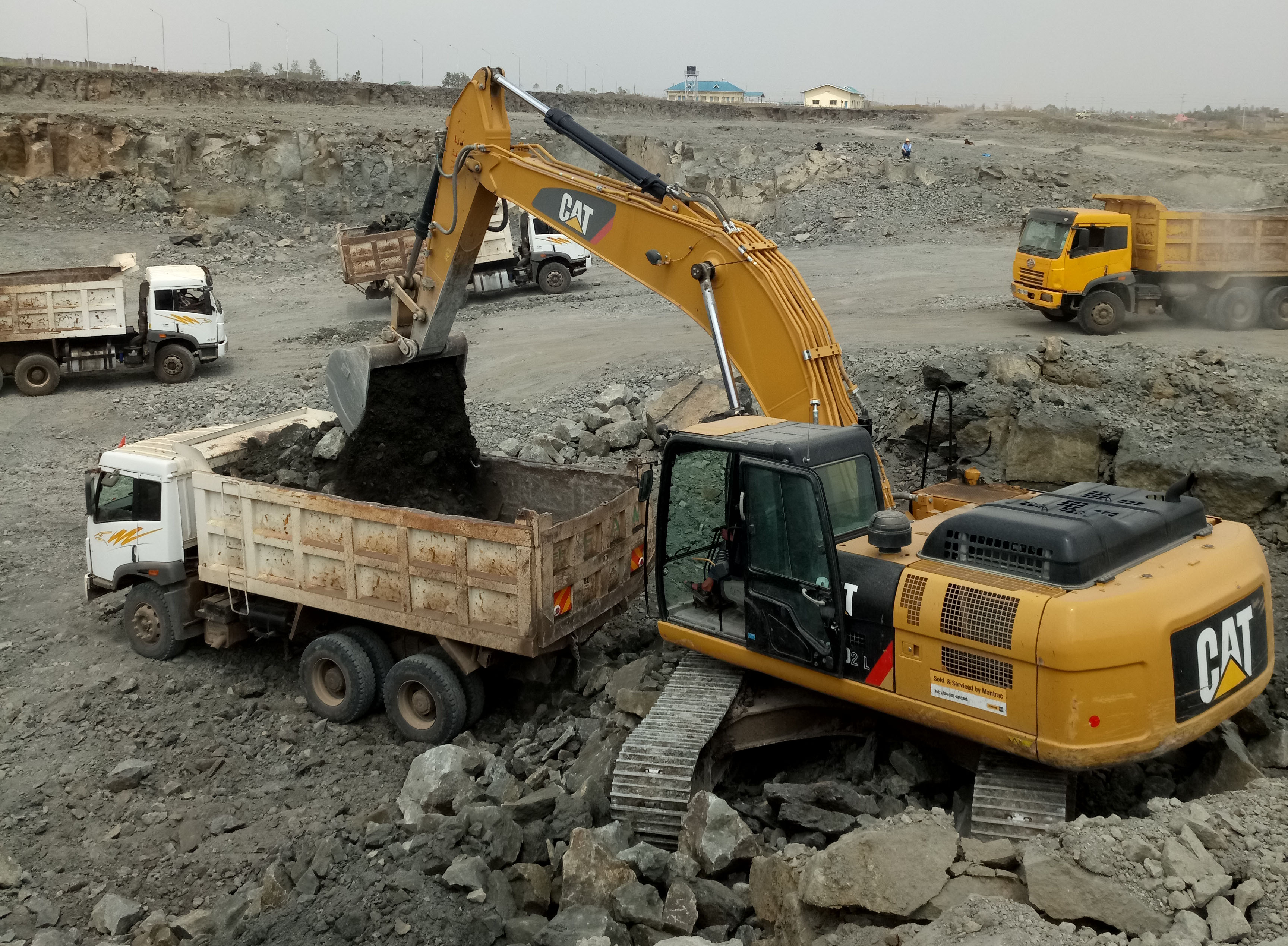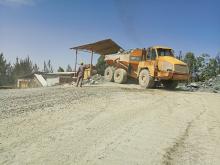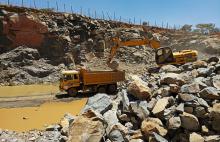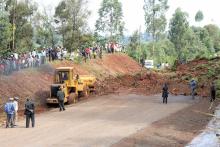
A large open pit quarry near Nairobi is the scene of great activity thanks to Kenya’s building boom. Shem Oirere reports.
Kenya’s real estate sector has been on a growth path for the last three years with its contribution to the country’s gross domestic product rising to 8.8% in 2016, up from 7.2% in 2015, according to Kenya National Bureau of Statistics.
The sector’s growth has triggered a huge demand for building stones and expansion of small and medium quarry operations to supply the construction material for additional office space, residential, industrial and special properties, especially in urban areas.
A combination of the increase in demand for building stones and a World Bank-financed sewerage project sited on a rocky location has given birth to the 82-acre plus Masitima open pit quarry, at Gatong’ora in Kenya’s Ruiru District near the capital Nairobi. Here, a blend of machinery and artisanal quarry operations are competing for a share to supply building stones to Nairobi and surrounding towns such as Kiambu, Limuru, Machakos, Mavoko, Kajiado, Thika, Tala, Kangundo, Masaku and Athi River.
“Our quarry is more or less a small to medium stone mining operation on a public piece of land that was formerly owned by Githunguri Constituency Ranching Company Ltd, before it was later allocated for Ruiru Municipal Council for public utility projects,” said Francis Ndung’u, the chairman of the Masitima quarry operators.
The 82 acres have been set aside for the construction of a waste water stabilisation pond sewerage treatment system and other sewerage structures to serve residential homes and industrial operations in Ruiru town and its environs.
The quarry site sits on igneous rock that consists of basalts, phenelites and granite, according to previous geological surveys by Kenya’s National Environmental Management Authority, the country’s state-owned environmental regulator.
“The operations of Masitima quarry are slightly different from other quarries in the country,” said Ndung’u, who has been the chairman of the quarry operators for the last year.
“The land was allocated for the waste water project, but because it sits on a rocky ground a group of people took advantage and subdivided it into portions to mine construction stones, to feed the growing market such as Nairobi and other surrounding towns,” he said.
Operations at the quarry changed after 2012 when the sewerage project was awarded to Chinese infrastructure development firm Sinohydro Corporation (SC). The company took possession of the land as the construction of the waste water stabilisation pond sewerage treatment system commenced. However, SC allowed those who had allocated themselves portions of the land for stone mining to carry out their operations.
“Now it is Sinohydro that is involved in the drilling and blasting of the rock before the quarry operators remove the large boulders and generated fines to create space for the construction of the sewerage bond foundation,” said Ndung’u.
“We are allowed five 4x2 dump trucks of the blasted stone out of which we give back to Sinohydro one truck of cut stone blocks that we make with hand tools,” said Ndung’u. The blasted stone varies in size with some being huge boulders that need to be broken further using hammers and wedges.
SC has surveyed and mapped for drilling the entire 82 acre piece of land. The drilling and blasting is being done in phases as the construction of the sewerage bonds progresses with the first phase of the sewerage bond infrastructure already completed.
The Chinese company provides the mining engineer, supervisor and blasting foreman for the planning, blast design, accuracy drilling, mixture of explosives, and blast explosion, albeit on a limited scale because of the size of the quarry.
“The company removes the top cotton soils using its excavators and dump trucks at spots already identified by the more than 60 quarry operators before it drills the rock up to about 3 metres (the depth of the sewerage bond),” he said.
A SC official, who introduced himself as Mr Ma, told ABI the drilling is done by a top hammer drill system but declined to give technical details of the rig system or talk in detail about initial quarry operations.
However, unlike modernised and high technology operated quarries, at Masitima there are no precise parameters to determine the position or pattern of holes; the operations are done “using the experience we have acquired working at this particular quarry,” said Ma.
The top hammer drill is powered by a Kaishan BKCY 15/13 diesel portable screw air compressor with displacement of capacity of 15 cubic metres/minute at 13 bar. Ma, however, could not confirm the power range of the compressor, although various online sources indicate it to be between 4kW to 355kW.
“Once the holes are drilled to a level of 10ft, after the removal of the top soil, they are loaded with an explosive, which is a mixture of ammonium nitrate and fuel oil that contains the standardised ratio of 94% to 6% respectively,” said Ndung’u. He said there is no standard way of measuring the amounts of the explosive but “they use right amounts based on years of blasting experience.’’
There are 60 quarry operators at the Masitima site. “Each of the operators has 17 to 25 unskilled and semi-skilled workers who cut the big stones into useable construction blocks,” said Ndung’u.
“These workers are not employed on permanent terms, but we pay them 50% of the cost of a block of stone that is ready for sale,” he said.
Loading work at Masitima quarry is done by a mixture of
At the quarry, the mined stones are prepared into building blocks that come in two sizes - 6x9 inches, sold for $0.10 a block; and 9x9 inches, sold for $0.20 a block.
“It is not easy to approximate how many bricks we sell annually because apart from the 60 quarry operators, there are other small operators who are not members of this group and who sell from a few blocks to a full lorry,” said Ndung’u.
Buyers of the building stone blocks at Masitima quarry pay a tax of $4 to the Kiambu County Government, of which Ruiru District (or sub county) is a part, for each loaded lorry.
Although it was not possible to get feedback from the county government on how much is collected daily from the Masitima quarry from taxed building stone, a report last year by the county’s economic planning department indicated the entire county earns $2,000 every day in revenue from quarry operations across Ruiru District.
“There are times in the year when we can go a whole day without selling a single lorry of the building stones, but we also have boom times,” said Ndung’u.
Health and safety is a major challenge at the Masitima quarry because the operations are very basic, especially the manual cutting of stones. The workers and operators have no protective gear to protect them from the effects of heavy clouds of dust generated from blasting of rocks at the quarry.
Much of the dust at Masitima comes from blasting of the rock, transportation of the blasted stone, loading of lorries with the stone and fines resulting from the blasting, and the dusty roads leading to the quarry.
“Some of the people have experienced health problems from inhaling the dust that comes both from the rock blasting and the dusty roads leading to the quarry especially during the dry season,” said Ndung’u.
The report by the Kiambu government says quarries in the county “have changed the landscape of the area leaving many openings, which poses dangers to motorists and residents”.
“I think at Masitima quarry the story is slightly different. We are mining stone and utilising the mined space for the construction of a sewerage facility, which is going to be one of the biggest in Kenya,” said Ndung’u.
“Although the project is taking up the quarry, it is a phased project, which means we will still be mining stone over the next five or so years,” he said.
According to Ndung’u, the proximity to Kenya’s capital Nairobi and other surrounding towns, and the booming construction industry, assures quarry operators in Ruiru district of a ready market for the building materials they produce.
The Kenya National Bureau of Statistics director general, Zachary Mwangi, says in 2016 the value of completed building works in Nairobi, the largest consumer of the Masitima quarry building stones, was $738 million, up from $686 million in 2015. In the ‘2016 Economic Survey’ compiled by the Bureau, Mwangi says $3 billion worth of building plans had been approved in Nairobi last year, an equivalent of a 43.3% increase from 2015’s $2 billion.
A recent report - ‘East Africa’s Building Boom’ - based on the region’s top 10 construction projects, puts Kenya as the biggest national beneficiary of the increased building market activity. Among the ten biggest regional construction schemes is Kenya’s $2.1bn Tatu City Project that will accommodate 150,000 people when complete.
“There is a lot of house construction, especially in towns neighbouring Nairobi such as Athi River, Rongai, Kajiado and Kangundo. Consumption of building material is set to go up in coming years, which means quarries, especially those in counties near these towns, will have good business,” said Ndung’u.
The main challenge for quarry operations in Ruiru District, according to a report by Kiambu County Government, is that “some of the quarries were excavated as early as 1970 and never rehabilitated”. The report adds that some of the quarries also posed a “security challenge” in the district.
Ndung’u said stranded water at the Masitima quarry, which is located along the Ruiru River, also requires constant pumping to ensure the health and safety of people working at the quarry. However, much of the water is barely two foot deep “and is only a problem during the rainy season”.
“Small pumps are used to pump out the water that is at times used to control dust, but on a smaller scale,” said Ndung’u.










